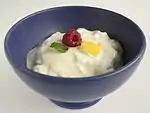Viili
Viili (Finnish) is a mesophilic fermented milk product found in Finland. This cultured milk snack resembles yoghurt and is the result of microbial action of lactic acid bacteria (LAB) and a surface-growing yeast-like fungus Geotrichum candidum present in milk, which forms a velvet-like surface on viili. In addition, most traditional viili cultures also contain yeast strains such as Kluveromyces marxianus and Pichia fermentans. The lactic acid bacteria identified in viili include the acid‐producing Lactococcus lactis subsp. lactis and L. l. cremoris as well as the aroma producers L. lactis subsp. lactis biovar diacetylactis and Leuconostoc mesenteroides.[1] Among those mesophilic LAB strains, the slime-forming Lc. lactis subsp. cremoris produce a phosphate-containing heteropolysaccharide, named viilian. Viilian is similar to kefiran produced by kefir grains. The production of exopolysaccharides (EPS) by the strain forms the consistency character of viili and it has been claimed to have various functional benefits toward the rheological properties of milk products and the health improving potential.
 Finnish viili with strawberries and blueberries | |
| Type | Fermented milk |
|---|---|
| Place of origin | Nordic countries |
| Main ingredients | Milk, bacterial and yeast culture |
In modern practice, pasteurized milk is used, fermentation is carried out in a dairy plant in controlled conditions using laboratory-grown cultures and the product sold fresh. Viili is widely available in Finland in grocery stores in several variants.
Other variants
Several variants of fermented milk products are found in Western Finland and Sweden, such as filmjölk ("viili milk") or långfil ("long viili"), which vary in consistency and fermentation. In Norway, filmjölk is usually named "kulturmelk" ("cultured milk") or "surmelk" ("sour milk"), while in Gotland and Iceland, the name "skyr" is used to refer to fermented yoghurt variants.
Cream viili (Finnish: kermaviili) is made from cream instead of milk, and is used in cooking like sour cream, or with dill, chives and other spices as cold sauce for fish, or as a base for dip sauces.
References
- Leporanta, K. 2003. Viili and Långfil – exotic fermented products from Scandinavia. Valio Foods & Functionals. On line version
- Mistry, V. V. 2004. Fermented liquid milk products. In: Handbook of food and beverage fermentation technology. (Ed. Y. H. Hui, L. Meunier-Goddik, Å. S. Hansen, J. Josephsen, W. Nip, P. S. Stanfield and F. Toldrá) Marcel Dekker, Inc. New York, U.S.A.
- Ruas-Madiedo, P., M. Gueimonde, C. G. De los Reyes-Gavilán and S. Salminen. 2006. Short communication: Effect of exopolysaccharide isolated from “viili” on the adhesion of probiotics and pathogens to intestinal mucus. J. Dairy Sci. 89:2355-2358.
- Shurtleff, W. and A. Aoyagi. 2004. History of Fermented Soymilk and Its products: History of Soybeans and Soyfoods: 1100 B.C. to the 1980s. Soyfoods Center, Lafayette, California.
- "Characterization of starter lactic acid bacteria from the Finnish fermented milk product viili". doi:10.1111/j.1365-2672.2008.03952.x. Cite journal requires
|journal=(help)
External links
![]() The dictionary definition of viili at Wiktionary
The dictionary definition of viili at Wiktionary
